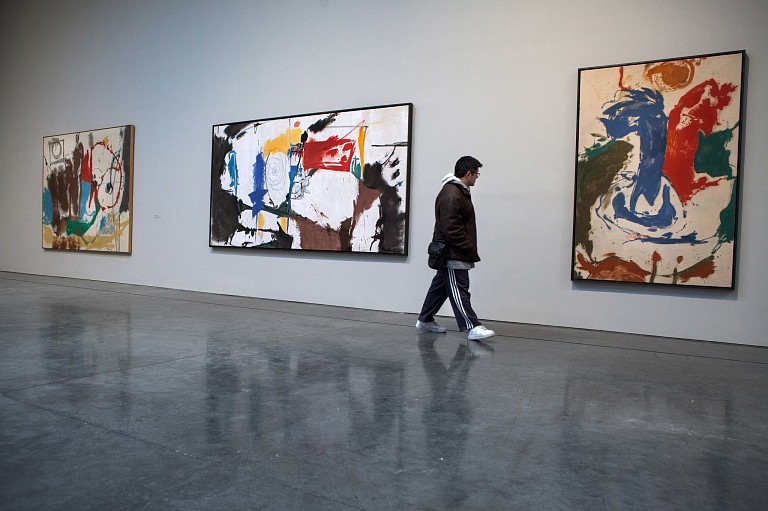
Want to Get Rich Buying Art? Invest in Women
September 24, 2018 - Mary Gabriel for The New York Times
More than ever, female artists are breaking sales records and being recognized for their role in important art movements.
Once, when asked about discrimination against female artists, the Abstract Expressionist Lee Krasner said the bias was as old as Judeo-Christian history. Brushing aside the weight of that realization, she added, “There’s nothing I can do about those 5,000 years.” She painted anyway, as have women throughout the ages who have continued to create despite official disdain.
Centuries and decades later, it seems their persistence may be finally paying off. Galleries are adding more women to their rosters, museums like the Uffizi in Florence are combing their storage facilities in search of treasures that deserve airing, and numerous institutions have been mounting exhibitions of art by women. On the eve of this fall’s auction season, the art market appears to be experiencing a long overdue correction.
While the highest price ever paid for an artwork by a woman continues to be a small fraction of that of men, last spring in New York, auction sales records were shattered for the works of 15 female artists, including Krasner’s fellow Abstract Expressionists Joan Mitchell, Helen Frankenthaler and Grace Hartigan. With additional important paintings by women on offer this season — among them Frankenthaler’s rare 1959 work, “Red Square” — there is every reason to expect that more records will tumble.
Anyone looking to invest in art should take heed.
The changed climate can be attributed to a host of causes: the increased focus on women’s rights across society, decades of activism by feminist artists and a simple matter of economics. But a much more gratifying reason is the belated recognition that work by women deserves support and attention because it is worthy.
“From the market perspective, when you have 15 mediocre [Willem] de Koonings come to market in a season and one amazing Joan Mitchell painting come to market in a season, the market is going to gravitate toward quality,” said Sara Friedlander, international director and head of postwar and contemporary art at Christie’s New York. “When the quality is really there, the market just explodes.”
During the first art market gold rush in the United States, in the mid-1950s, Fortune magazine advised its readers on investing in art. It identified three categories: Old Masters (a description that denotes the longstanding gender bias), “blue chip” works, and the “speculative” or “growth” arena. The latter group included paintings by newly discovered artists, which, though a risky investment, showed enormous potential. The unknown artists Fortune included in that category are largely household names today: de Kooning, Robert Motherwell, Jackson Pollock, Franz Kline and Larry Rivers. Notably absent from the list were any of their female colleagues.
Today’s “growth” area would undoubtedly include them. Female artists have been neglected for so long that their work — even if it was painted 70 years ago — feels new and cutting edge. For collectors, it has the irresistible allure of discovery.
“When you make a world record price for an artist, living or dead, there is a celebration that goes with that,” Ms. Friedlander said. “But it’s not that simple. It can’t just be that Joan Mitchell sells for $17 million; it has to also be that there is a real cultural and curatorial shift in the way in which people look at that work.”
It can be argued that this shift is already underway. For female artists working today, though the fight for equal recognition is not won, that goal is closer — at least at the gallery level. A study by the City University of New York’s Guttman Community College found that during the 2016-17 period, 30 percent of the artists represented by the top New York galleries were women. While that is still too low, especially since women make up 51 percent of the professional artists working in the United States, it is a great improvement on the late 1980s. A tally by the Guerrilla Girls, feminist activist artists, found that the number of shows by female artists at 17 of the leading galleries during the 1986-87 art season was between zero and four. Now, female artists like Amy Sillman, Marlene Dumas and Kara Walker are as well known and influential as their male counterparts.
Ensuring that the momentum continues requires vigilance and commitment, because we have been here before. In 1957, two years after the famous Fortune article, female artists were all the rage, even feted in Life magazine as being “in ascendance.” But when market tastes shifted to Pop, women were once again relegated to their traditional place in the history of art — nowhere.
That history is not just wrong, it is built on a false premise. The Abstract Expressionist story, for example, has been the tale of a few macho men and yet the late art historian Irving Sandler told me that with female artists like Hartigan, Mitchell, and Frankenthaler in the 1950s “it was a new ball game. They opened it up for women, in part because they were stronger” than any of the men of their generation.
In Western art, the names most often associated with the earliest nonobjective abstract painting are Wassily Kandinsky, Kazimir Malevich, Piet Mondrian, Robert Delaunay, and Frantisek Kupka. Yet, as a new Guggenheim show of works by the unheralded Swedish artist Hilma af Klint that opens next month makes clear, Klint created completely abstract works years before these men.
Indeed, women have made great art since artists first put charcoal to stone or oil to canvas, and there is plenty of important work, old and new, by women. Curators and collectors just need to adjust their lenses and give that work its full due.
Back to News
